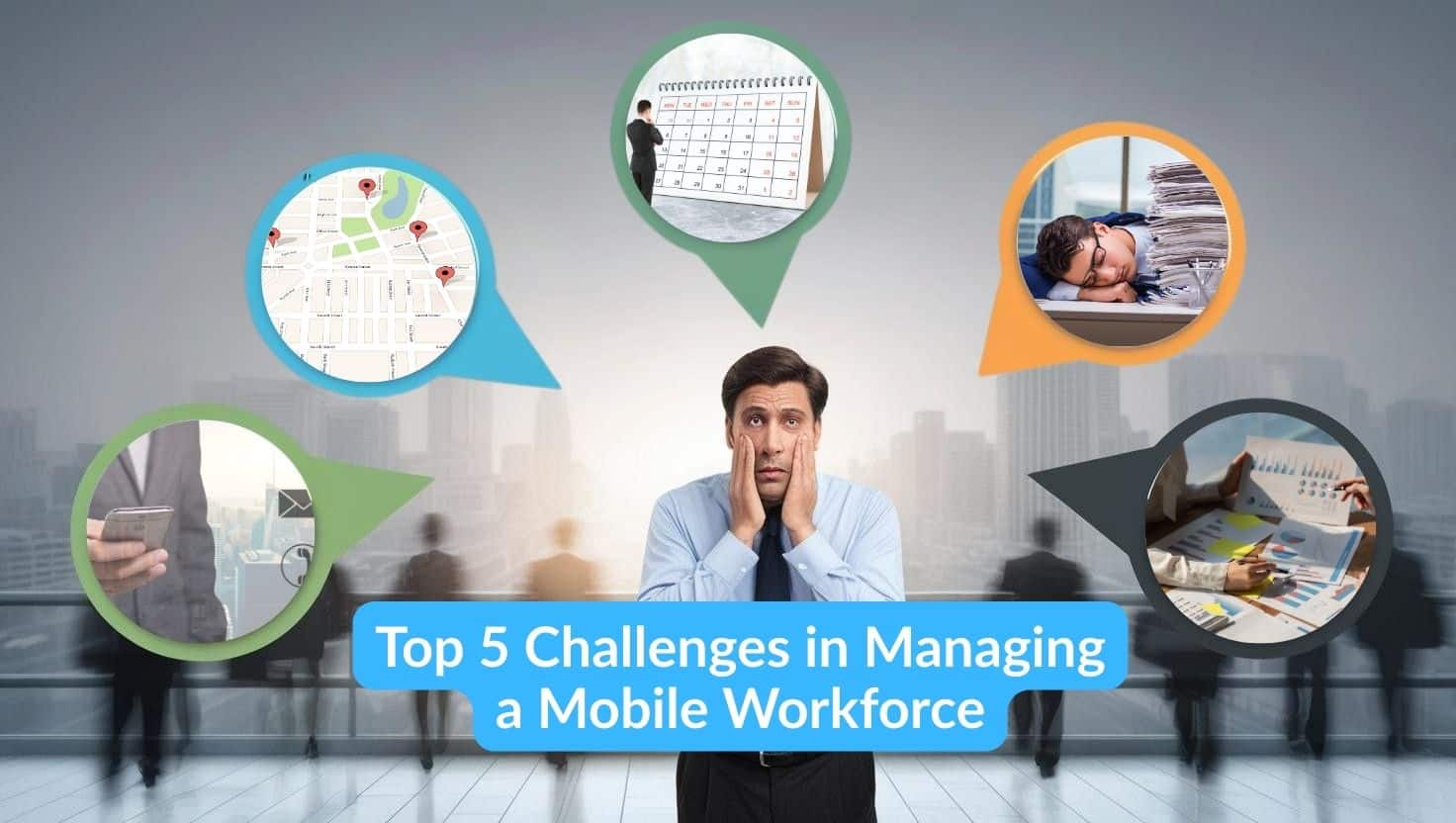
Top 5 Challenges in Managing a Mobile Workforce and How to Solve Them

Ever tried herding cats? That’s what managing a mobile workforce can feel like on the worst days. When your team is scattered across job sites, service calls, or delivery routes, traditional management approaches crumble fast.
I’ve spent months talking with dozens of field service managers, construction supervisors, and delivery coordinators in the trenches daily. No matter the industry, the same frustrations keep popping up. Let’s dig into the five biggest headaches—and what actually works to solve them in the real world.
Challenge 1: The "Where Is Everyone?" Problem
We’ve all been there. It’s 10 AM, you’re juggling three customer calls, and suddenly you realize you have no clue if your technician made it to the Wilson job, whether your installer is still stuck at that morning appointment, or if anyone is available for the emergency that just landed in your inbox.
This blindspot creates a domino effect that ruins your day. Customer calls pile up because you’re busy playing detective to track down your team. Emergency jobs get assigned to whoever answers their phone first, not who’s actually closest. And there’s always that one customer swearing “nobody ever showed up”—though your tech insists they were there for an hour.
What Actually Works:
Smart location systems have been a game-changer for my clients—when implemented the right way. The options basically break down into two approaches:
Geo-fencing creates virtual boundaries around job sites or client locations. When someone on your team crosses that invisible line, the system automatically logs their arrival or departure. It’s like having a digital time clock at every location without making anyone remember to punch in.
A landscaping buddy of mine tried geo-fencing and discovered his crew was unintentionally costing him about 45 minutes per worker each day through inaccurate time reporting. Not because anyone was being dishonest, but because everyone rounded up. “Got there around 8:15” became 8:00 on the timesheet. Those little discrepancies were bleeding thousands in unnecessary payroll costs.
GPS tracking gives you that continuous visibility throughout the day. While it offers more detail than geo-fencing, you have to roll it out thoughtfully so your team doesn’t feel like they’re under surveillance.
When done right, GPS tracking does so much more than just help you keep tabs. A friend who runs an emergency plumbing company cut their average response time by 17 minutes after implementing GPS dispatch, potentially saving customers thousands in water damage on those middle-of-the-night calls we all dread.
The best solutions today offer both options, so you can dial in the right level of visibility for different situations.
Challenge 2: The Scheduling Nightmare
If you’ve ever done manual scheduling for field teams, you know it’s a special kind of torture. Trying to juggle travel time, technician skills, job duration, and customer preferences in your head (or even in Excel) is a recipe for disaster—either your team is sitting around waiting between jobs, or you’re constantly putting out fires from schedule changes.
The hidden cost here is staggering. An HVAC company I consulted for discovered their technicians were burning nearly 40% of their day just driving between jobs before we optimized their schedules. That’s almost half the day spent looking at taillights instead of fixing units!
What Actually Works:
The real breakthrough comes from intelligent scheduling that accounts for all the moving pieces:
- Actual travel times (not just the distance on a map)
- Who has the right skills and certifications for each job
- Job priority and service-level promises
- What equipment needs to be on the truck
- How long similar jobs have taken in the past
Today’s tools use smart algorithms to create optimized schedules and routes that maximize productivity while keeping windshield time to a minimum.
One small electrical contractor I worked with implemented smart scheduling and found they could handle 4-5 more service calls per day across their 8-person team—without making anyone work longer hours. The system simply reduced drive time by finding more efficient routes and grouping nearby jobs together. That’s money in the bank without adding overhead.
Challenge 3: The Paperwork Mountain
We all hate paperwork, but field work generates mountains of it—job orders, compliance forms, inspection reports, customer sign-offs, inventory lists, time tracking, and invoices. The traditional paper processes are a recipe for headaches:
- Forms mysteriously vanish or get soaked in coffee
- Some techs have handwriting that might as well be ancient hieroglyphics
- Poor Betty in the office has to enter the same information three different times
- Invoicing gets delayed for days while waiting for paperwork to trickle in
- Customers call to dispute charges weeks later because they “never approved that work”
I’ll never forget the construction manager who admitted he spent every Sunday afternoon hunched over his kitchen table deciphering last week’s job sheets—time that should have been spent with his kids or prepping for Monday.
What Actually Works:
Digital workflows have completely transformed this pain point. Using mobile-friendly forms, technicians can capture everything once, right there at the job site.
The must-have features include:
- Forms that adjust based on the type of job (no more irrelevant fields!)
- The ability to snap photos and get signatures on the spot
- Real-time tracking of parts and inventory
- Forms that work even when cell service doesn’t
- Everything syncs automatically when the connection returns
A plumbing service owner I know digitized their workflows and watched their average time-to-invoice plummet from 11 days to less than 24 hours. Not only did faster invoicing improve cash flow, but those digital records slashed billing disputes by giving customers clear documentation of the work performed. No more he-said-she-said about what was actually done.
Challenge 4: The Communication Black Hole
When your team is scattered across different zip codes, communication falls apart fast. Updates get missed. Questions sit unanswered. Critical context never reaches the people who need it.
One service manager described it perfectly: “By mid-afternoon, I’ve got three technicians texting me, two calling my cell, and another sending emails—all while I’m trying to handle an angry customer on the phone. Stuff falls through the cracks, and nobody has the full picture.”
These communication gaps lead to rework, confused customers, and teams who feel disconnected from headquarters and each other. I’ve seen good technicians quit over this frustration alone.
What Actually Works:
The solution is having unified communication channels that bring everyone—office staff, managers, and field teams—into a single conversation. Instead of information scattered across texts, calls, emails and sticky notes, everyone accesses the same platform.
The non-negotiable capabilities include:
- Job-specific messaging that keeps all communications about a particular work order in one thread
- Easy team-wide announcements for those “everyone needs to know this” moments
- Complete customer history visible to anyone handling the account
- Simple file sharing for manuals or reference materials
- Video capability for those times when a technician needs a second pair of eyes
A pest control company I advised implemented unified communications and saw their callbacks for incomplete service drop by 62% in just the first quarter. When technicians could easily see previous treatment notes and chat with the tech who was there last time, they solved problems completely the first time around.
Challenge 5: The Inconsistent Customer Experience
When field operations are disjointed, customers feel it immediately. Your “sometime between 8-5” arrival windows feel like a bad joke. Different technicians give completely different answers to the same question. Follow-up calls fall into the void.
In today’s review-obsessed world, these inconsistencies hit your bottom line hard and fast. The research is clear—customers who experience delays or communication problems are 67% more likely to jump ship when competitors come knocking.
What Actually Works:
The field service companies crushing it today focus on managing the entire customer journey, not just the individual job. This approach wraps in:
- Automatic appointment reminders that actually work
- Real-time technician ETAs that update if things change
- Complete service history available to any team member
- Structured follow-up processes that don’t rely on memory
- Smart review generation for those five-star experiences
One home services company I worked with implemented automated ETA notifications and watched their customer satisfaction scores jump by 22% in just two months. The improvement wasn’t from faster service—their techs took the same amount of time—but from eliminating that maddening uncertainty. Customers knew exactly when technicians would arrive and could plan their day accordingly.
Putting It All Together
While each challenge has specific fixes, the biggest wins come when all aspects of field management work together in a single system. It’s like the difference between an orchestra and five soloists playing in separate rooms.
Modern platforms like Spryple CRM deliver this integration through a comprehensive approach to mobile workforce management. By connecting location tracking, scheduling, documentation, communication, and customer management, these tools break down the silos that typically plague field operations.
Spryple stands out by offering:
- Flexible location management with both geo-fencing and GPS options
- AI-powered scheduling that actually understands how field work happens
- Digital workflows that eliminate paperwork headaches
- Unified communication that keeps everyone in the loop
- Complete customer journey management from first call to follow-up
Beyond the Technology: Making It Work
I’ve seen too many companies buy fancy software only to have it gather digital dust. No tool, no matter how powerful, succeeds without considering the human element. The implementations that actually stick follow these principles:
- Start with clear, specific goals — Target your biggest pain points rather than trying to overhaul everything at once.
- Get your team involved early — The people in the field often have the best insights into what will actually work when they’re knee-deep in a job site.
- Be completely transparent about tracking — Explain exactly what location data is used for and how it benefits everyone, not just management.
- Measure outcomes, not activities — Focus on completed jobs and happy customers, not how many minutes someone spent at a site.
- Celebrate the wins — When teams see concrete benefits from new systems, they become your biggest advocates.
The Bottom Line
Managing today’s mobile workforce means leaving behind those outdated, piecemeal approaches that worked fine in 2010 but fall flat today. The companies seeing the greatest success are embracing integrated platforms that provide visibility without sacrificing trust, efficiency without adding complexity, and customer focus without burdening field teams.
Solutions like Spryple deliver this integrated approach, helping organizations tackle the five critical challenges of mobile workforce management while improving outcomes for everyone involved.
When the right technology meets thoughtful implementation, mobile teams don’t just survive—they thrive. And as someone who’s seen the before-and-after many times now, I can tell you the difference is night and day.












